
AI marketing tools use artificial intelligence to handle parts of marketing that once required hours of manual work or deep data crunching. They analyze information, detect patterns, and make smart recommendations in real time. They’re not just reporting tools. They’re active teammates that help you think, create, and move faster.
Some help you write content. Others build campaigns, find new audiences, or figure out which customers are most likely to buy. But every one of them exists to make your marketing sharper and more efficient.
Think of them as a digital partner that works beside you. They take in millions of data points, spot trends instantly, and surface ideas you’d probably miss. The goal is simple: help you make better marketing decisions with less effort.
Traditional marketing had a rhythm that felt slow and clunky. You’d brainstorm, plan, design, launch, and then wait weeks for data. By the time you got the results, your audience had already moved on.
AI changed that rhythm completely. You can now spin up campaigns in a few hours, test different messages, and see what works almost immediately. Small teams can move like giant ones.
Instead of using static customer personas, AI updates your audience segments based on live behavior. Instead of sending the same email to everyone, you can tailor each message to match a person’s intent or buying stage. And instead of spending nights buried in spreadsheets, you get clear insights on what will convert next.
When you connect these tools, you build something bigger than automation. You build a marketing system that thinks and reacts in real time. It collects signals, acts on them, and learns as it goes.
Tools like Jasper and Copy.ai can help write ad copy that fits your audience perfectly. You give them a short brief, and they return several versions you can test right away. It feels like having a creative partner who never sleeps and never runs out of ideas.
If ranking on search engines is part of your game, AI tools such as SEMrush or Surfer SEO give you a serious edge. They break down what’s working for your competitors and show you exactly how to improve your own content. They’re like SEO coaches built into your workflow.
AI doesn’t just look at who people are. It studies what they do, when they do it, and what it means. That allows you to target based on signals, not assumptions. You stop guessing who might buy and start reaching the people who are already showing intent.
AI marketing tools don’t just make life easier. They change the way teams operate. You move from reacting to predicting, from guessing to knowing. Let’s break down what that really means.
Marketing used to rely on waiting. Waiting for creative approvals, waiting for data, waiting for feedback. AI cuts that wait time down to minutes. Copy generation, ad testing, and analytics all happen faster, so teams can launch more campaigns without burning out.
It’s like suddenly having a few extra teammates who handle the repetitive parts of your job. You can focus on the big picture while the tools handle the grunt work in the background.
The days of blasting one generic message to everyone are long gone. AI studies behavior patterns, buying triggers, and engagement signals to predict what someone actually wants to see. That level of precision means higher click rates, better conversions, and a stronger brand experience.
When your message matches someone’s moment, you earn attention instead of forcing it.
AI doesn’t just tell you what happened. It helps you see what’s likely to happen next. You can spot when a lead is warming up, when churn is coming, or when it’s time to double down on a specific campaign.
For marketers, that’s power. Decisions become proactive instead of reactive.
Executives love numbers, and AI marketing tools bring plenty of them. They cut manual hours, increase response rates, and reduce wasted spend. If you compare the cost of one tool to the time it saves, the math almost always favors the investment.
The best part? The insights these tools generate often improve performance across multiple channels. You might start by automating emails, then realize your paid ads and content strategy both benefit from the same data. That ripple effect compounds ROI over time.
AI turns marketing from an expense into an asset that learns, scales, and pays back faster.
Here’s the truth: AI isn’t perfect. Some tools overpromise or create content that sounds too robotic. Others need clean, structured data to work well, and that takes effort.
There’s also the human factor. Teams need to learn how to use these tools properly, set clear goals, and keep creativity in the loop. AI can accelerate results, but it still needs direction.
Finally, privacy rules are tightening worldwide. If your AI tools touch customer data, make sure you know how that data is collected, stored, and used. It’s not just about compliance. It’s about trust.
When you find the right balance between automation and human touch, AI marketing tools stop being shiny tech and start becoming a real growth engine.
AI marketing tools now cover nearly every part of the customer journey. From market research to customer growth, each category serves a unique purpose. Together, they create a connected marketing system that moves faster and learns as it goes.
Before you run a campaign, you need to understand where your audience actually is and what they care about. That’s where AI-powered research tools come in. Platforms like SparkToro, SimilarWeb, and SEMrush help marketers uncover audience behavior, keyword trends, and competitive insights in seconds.
These tools scan the web, pull real market data, and translate it into a practical strategy. You can see which channels drive traffic, what topics resonate, and even how your competitors attract visitors. The guesswork disappears, and your targeting becomes data-driven from day one.
Social media never stops, and neither can your brand. AI-driven tools like Sprout Social, Hootsuite, and Later help teams plan, schedule, and optimize content across platforms. They analyze engagement patterns, recommend the best posting times, and even flag trending topics your brand should join.
Instead of juggling five tabs and multiple logins, you can manage your community, track performance, and measure campaign impact all in one place. It’s how teams stay consistent without burning out.
AI has completely changed how campaigns run behind the scenes. Tools such as HubSpot Marketing Hub, ActiveCampaign, and Klaviyo let marketers design complex customer journeys with simple triggers and actions.
You can automate emails, lead nurturing, and retargeting sequences without needing a developer. The magic lies in how these platforms use data. They adapt to user behavior, send messages at the right moment, and ensure your outreach feels timely instead of repetitive.
Automation doesn’t just save time. It keeps your brand active 24/7 while maintaining a personal touch.
If data is the brain of marketing, feedback is the heartbeat. Tools like Wynter, Qualtrics, and Hotjar help companies understand how customers actually experience their brand. They capture user reactions, survey responses, and on-page behavior so you can see what’s working and what’s confusing.
The goal isn’t just to collect feedback but to act on it. These tools reveal hidden friction points in your website or messaging and help you refine campaigns based on real voices, not internal opinions.
A solid CRM system ties everything together. Tools such as Salesforce Marketing, HubSpot CRM, and Zoho CRM organize your contacts, track conversations, and measure pipeline health.
Modern CRMs use AI to predict which leads are most likely to convert, flag deals at risk, and surface insights your team can act on immediately. It’s no longer just a database. It’s a growth engine that guides your next move.
Every marketer needs fresh ideas and strong visuals. AI tools like Canva, Jasper, and Copy.ai make that part effortless. They help generate on-brand copy, design assets, and campaign materials in minutes.
Whether you’re building a new landing page, refreshing an email sequence, or testing ad variations, these tools keep your creative pipeline full. They’re like an on-demand content team that never runs out of energy.
When you combine all six categories, you get a full AI marketing ecosystem that can research, plan, execute, and improve every part of your go-to-market motion.
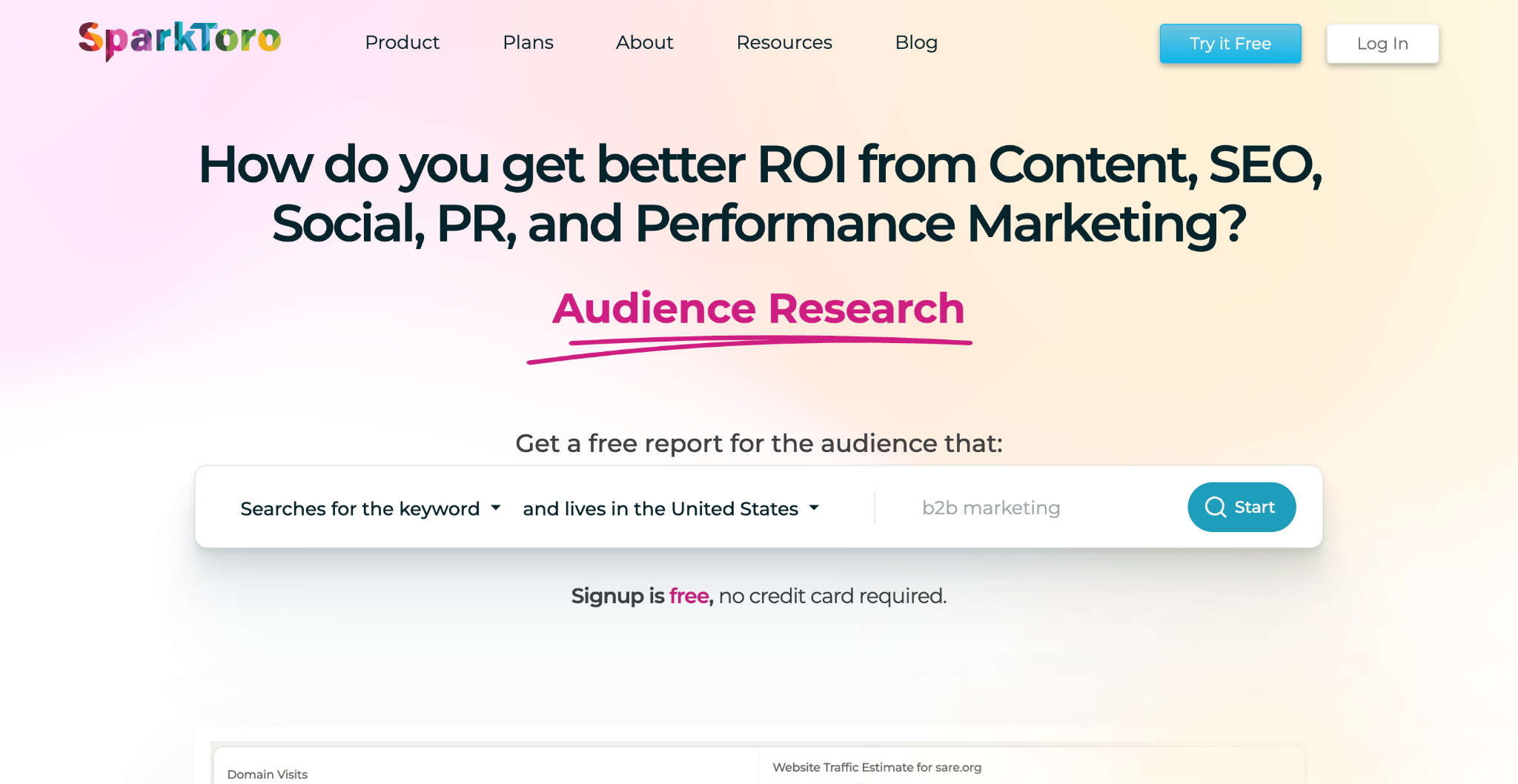
Audience intelligence for marketers who want to understand what really drives their buyers. SparkToro shows which websites, podcasts, and social accounts your audience follows. It replaces guesswork with real data about where your potential customers spend time online.
Best for brand and demand marketers who want to find niche communities and target smarter.
Pros
Cons
Who gets the most value?
Content marketers, growth strategists, and agencies that want to understand their audience before launching a campaign. It’s especially useful for teams that rely on organic and community-driven channels.
Quick setup tip
Start by searching your top five customer job titles. Review shared interests, social accounts, and podcasts they follow. Use that insight to refine where you spend ad or content dollars.
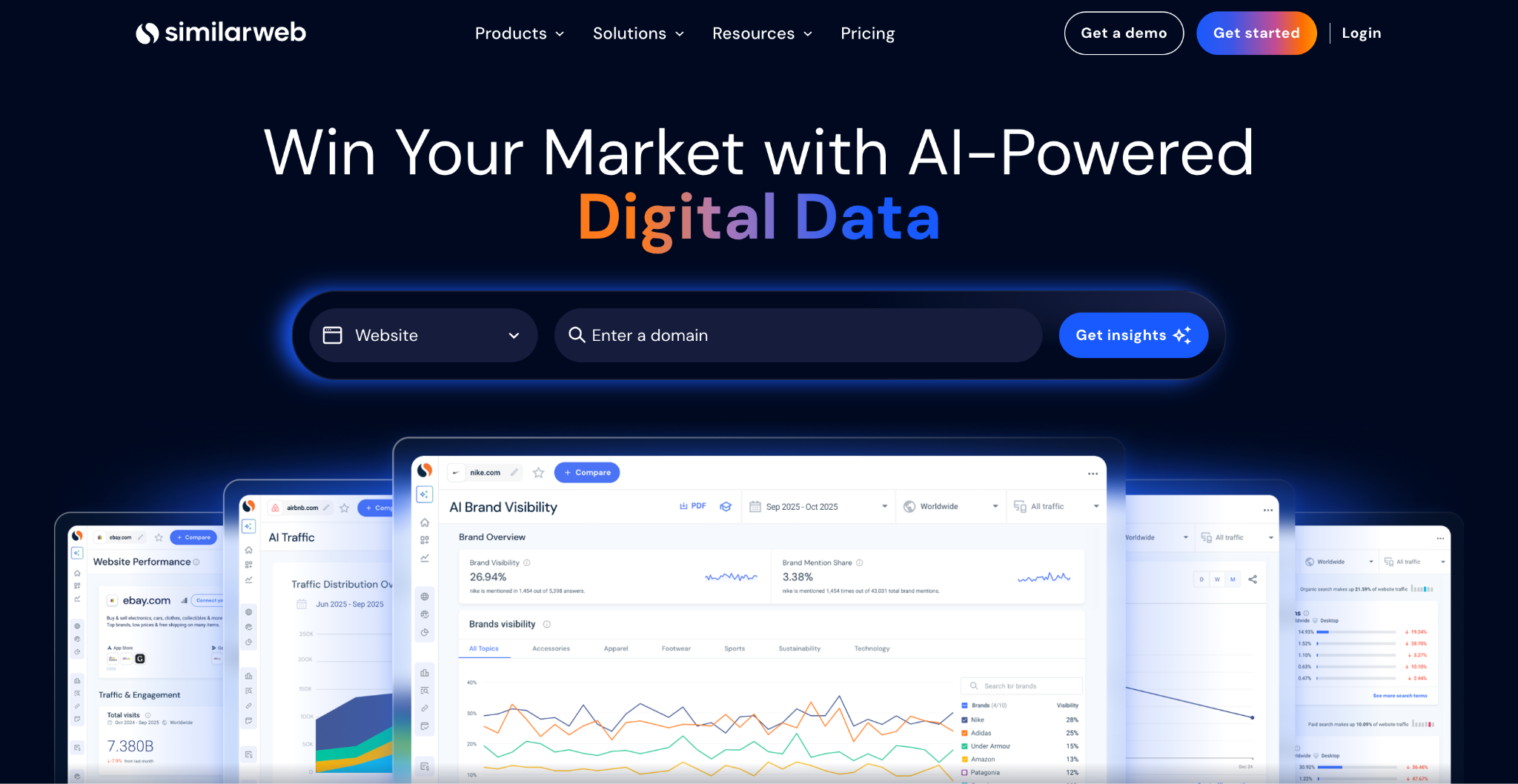
A digital intelligence platform that reveals how competitors drive traffic, where their audience comes from, and how their campaigns perform. SimilarWeb provides visibility into industry benchmarks, referral sources, and engagement metrics that shape your strategy.
Best for performance marketers and growth leads who want clear competitive benchmarks and traffic trends.
Pros
Cons
Who gets the most value?
Marketers in competitive industries who need to monitor rival strategies or evaluate new markets. It’s great for agencies building performance reports and executives planning expansion.
Quick setup tip
Create a custom list of your top five competitors. Compare traffic sources monthly to see which channels are gaining traction and which are losing ground.

A leading platform for keyword research, SEO optimization, and competitive analysis. SEMrush combines content, ads, and social tracking into one place, helping teams see what drives traffic and conversions across the web.
Best for marketing teams that balance content, search, and paid campaigns.
Pros
ConsIt can feel complex for new users due to its wide range of features.
Who gets the most value??
Growth teams, agencies, and SEOs who need actionable data to shape strategy. It’s also ideal for companies that want to connect SEO insights with paid media and content marketing.
Quick setup tip
Use the “Keyword Gap” tool to compare your site with your top three competitors. Identify keywords they rank for that you don’t, then create content to close those gaps.

HubSpot Marketing Hub is an all-in-one platform that helps you attract, nurture, and convert leads through connected campaigns. It brings together email marketing, CRM data, automation workflows, and analytics in one clean interface. Everything syncs, which makes it easy to see how every touchpoint contributes to pipeline growth.
Best for growing teams that want marketing, sales, and CRM data under one roof.
Pros
Cons
Who gets the most value?
Mid-market teams ready to move beyond one-off email tools. If you need a marketing system that scales as you grow, HubSpot delivers clear visibility and predictable results.
Quick setup tip
Start by building one workflow for lead nurturing. Use contact segmentation by persona or deal stage, then monitor engagement before expanding to new journeys.
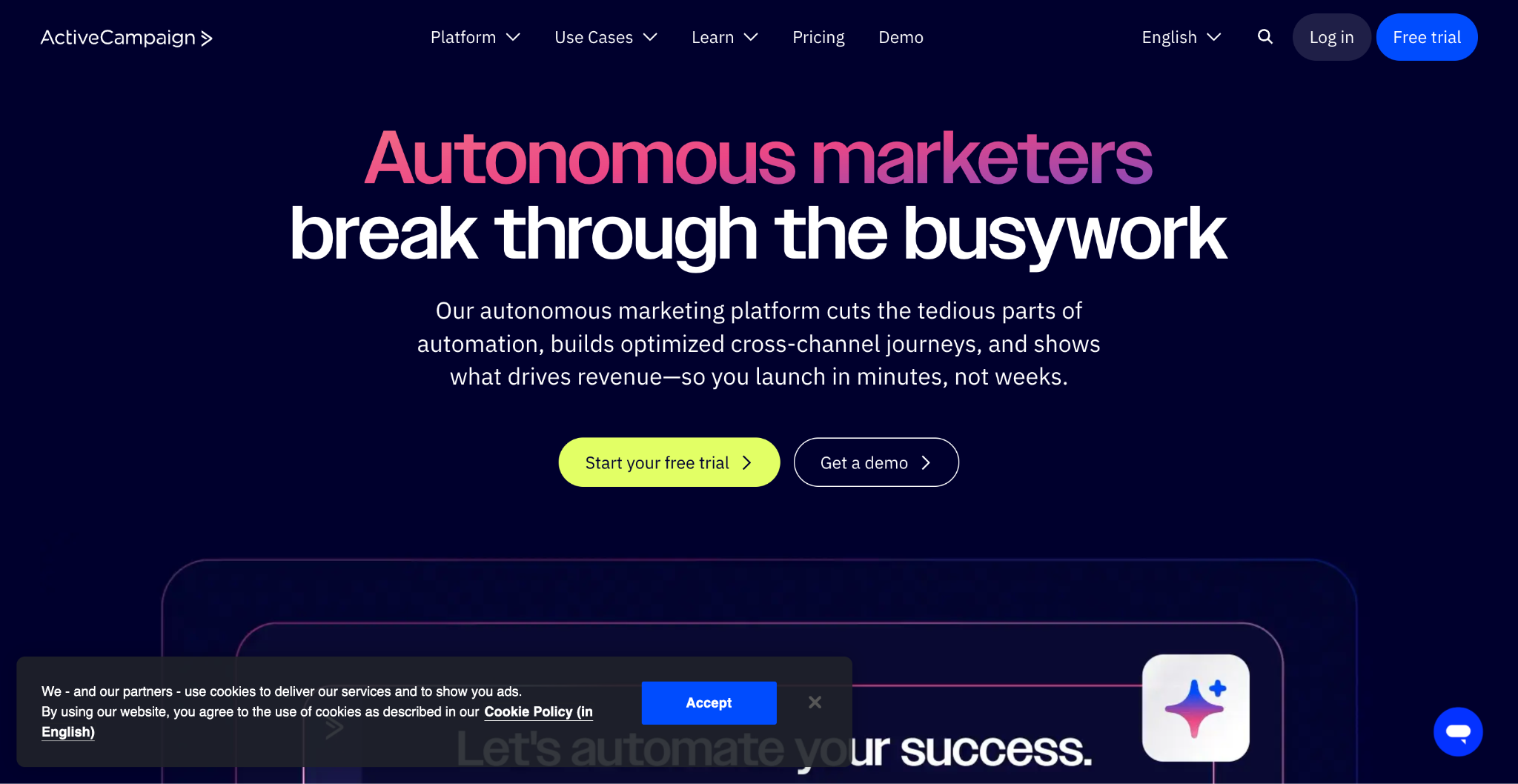
ActiveCampaign focuses on personalized automation. It helps marketers send the right message at the right time, powered by AI-driven insights into customer behavior. It combines email marketing, automation, and CRM capabilities, giving teams control over every step of the customer journey.
Best for digital-first companies that prioritize personalization and lifecycle marketing.
Pros
Cons
Who gets the most value?
Marketers who want to build multi-step, behavior-based campaigns without a heavy tech stack. It’s especially strong for B2C brands with repeat-purchase cycles.
Quick setup tip
Start small. Automate one follow-up sequence for new leads. Add conditional branches over time based on how people interact with your emails.

Klaviyo is a top choice for e-commerce marketing automation. It specializes in using customer data to trigger timely and relevant messages across email and SMS. The platform helps brands increase repeat sales and loyalty by reacting instantly to shopping behavior.
Best for ecommerce brands and online retailers that rely on strong retention and personalized communication.
Pros
Cons
Who gets the most value?
Ecommerce marketers who want automation that feels personal. Klaviyo turns customer behavior into conversion moments with minimal manual effort.
Quick setup tip
Activate your abandoned cart and post-purchase flows first. Those two automations often recover the fastest revenue and give you early proof of ROI.

Wynter helps you understand what your audience really thinks of your marketing. It tests your messaging with panels of real professionals in your target market, so you get honest feedback before launching. The result is clearer positioning and higher-performing copy without endless guessing.
Best for marketers and founders who want to validate messaging before spending on campaigns.
Pros
Cons
Who gets the most value?
Go-to-market and product marketing teams that test new narratives or campaigns often. Wynter helps you find the words that actually resonate before your audience scrolls past.
Quick setup tip
Pick one page or email sequence that matters most. Run a Wynter test with 20 professionals in your target role. Review the top insights and rewrite your copy using the phrases they respond to most.

Qualtrics is a full-scale experience management platform that gathers customer, employee, and brand feedback. It uses AI to analyze responses and detect patterns in sentiment, helping teams make informed decisions quickly.
Best for enterprise organizations that need deep feedback loops across multiple departments.
Pros
Cons
Who gets the most value?
Large teams that need a central source of truth for customer experience. It’s ideal for brands tracking satisfaction scores and long-term loyalty metrics.
Quick setup tip
Start with one core metric like Net Promoter Score or Customer Satisfaction. Automate surveys at key touchpoints, such as post-purchase or renewal, to capture consistent data.

Hotjar helps you see what customers actually do on your website. It turns visitor sessions into heatmaps and screen recordings that reveal where people click, scroll, or get stuck. It bridges the gap between analytics and human behavior.
Best for growth marketers and UX teams who want to improve site conversion and experience.
Pros
Cons
Who gets the most value?
Teams that want to understand the “why” behind user behavior. It’s great for spotting friction, improving funnels, and validating design decisions.
Quick setup tip
Set up heatmaps on your homepage, pricing page, and checkout flow. After a week of traffic, review scroll depth and click zones to identify what content users miss or skip.

Salesforce Marketing brings enterprise-level personalization to every campaign. It connects data across email, social, and advertising so you can create customer journeys that feel relevant at every step. Its AI features predict engagement patterns and recommend next best actions automatically.
Best for large organizations that need deep integration between marketing, sales, and service teams.
Pros
Cons
Who gets the most value?
Enterprise teams running multi-channel campaigns with long sales cycles. If you need to unify marketing and CRM data under one roof, Salesforce is a strong backbone for growth.
Quick setup tip
Start with a single customer journey, like post-purchase engagement. Use built-in templates to automate follow-ups, then expand into cross-sell and reactivation campaigns once results stabilize.

HubSpot CRM gives small and mid-sized businesses the same clarity that enterprise systems promise, but without the complexity. It centralizes contact data, email tracking, and deal management while staying easy to use.
Best for teams that want a CRM that feels intuitive and connects easily to marketing automation.
Pros
Cons
Who gets the most value?
Small and growing teams that want quick visibility into their pipeline. If you’re running both marketing and sales in one platform, HubSpot keeps everyone aligned without heavy setup.
Quick setup tip
Import your top 100 contacts and tag them by lifecycle stage. Set up automated reminders for follow-ups, then review your deal board weekly to spot stalled opportunities.

Zoho CRM focuses on simplicity and affordability while still offering automation and analytics that drive sales performance. It uses AI through its assistant, Zia, to predict outcomes, highlight key trends, and suggest next actions based on past data.
Best for startups and small businesses that want automation without the enterprise price tag.
Pros
Cons
Who gets the most value?
Budget-conscious teams that still want automation and insight. If you’re scaling up from spreadsheets or basic tools, Zoho CRM offers a balanced mix of structure and flexibility.
Quick setup tip
Start by creating one automated rule: when a new lead enters, assign it to the right rep and send a follow-up task automatically. Build from there as your data grows.
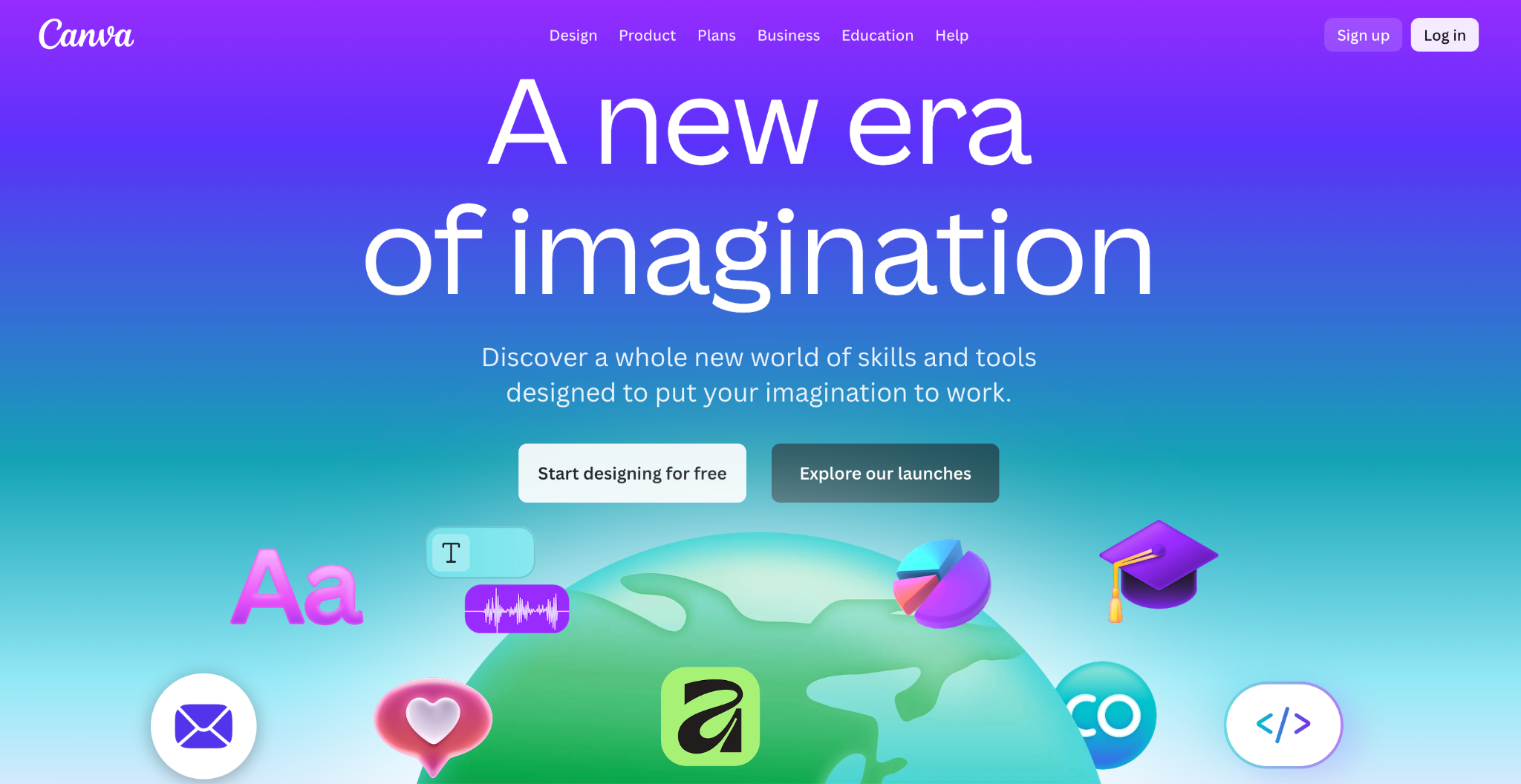
Canva gives marketers and creators the ability to design professional visuals without needing a full design team. It includes templates, brand kits, and AI tools that help you create everything from ads to pitch decks. You can adjust layouts, resize for different platforms, and keep all creative assets consistent across campaigns.
Best for marketing teams that want fast, branded visuals for social, email, and presentation use.
Pros
Cons
Who gets the most value? Marketing teams, agencies, and founders who need professional-looking content fast. Canva helps you move from idea to polished creative in minutes.
Quick setup tip: Build a brand kit with your colors, fonts, and logo before you start. It saves time later and keeps every campaign consistent across channels.
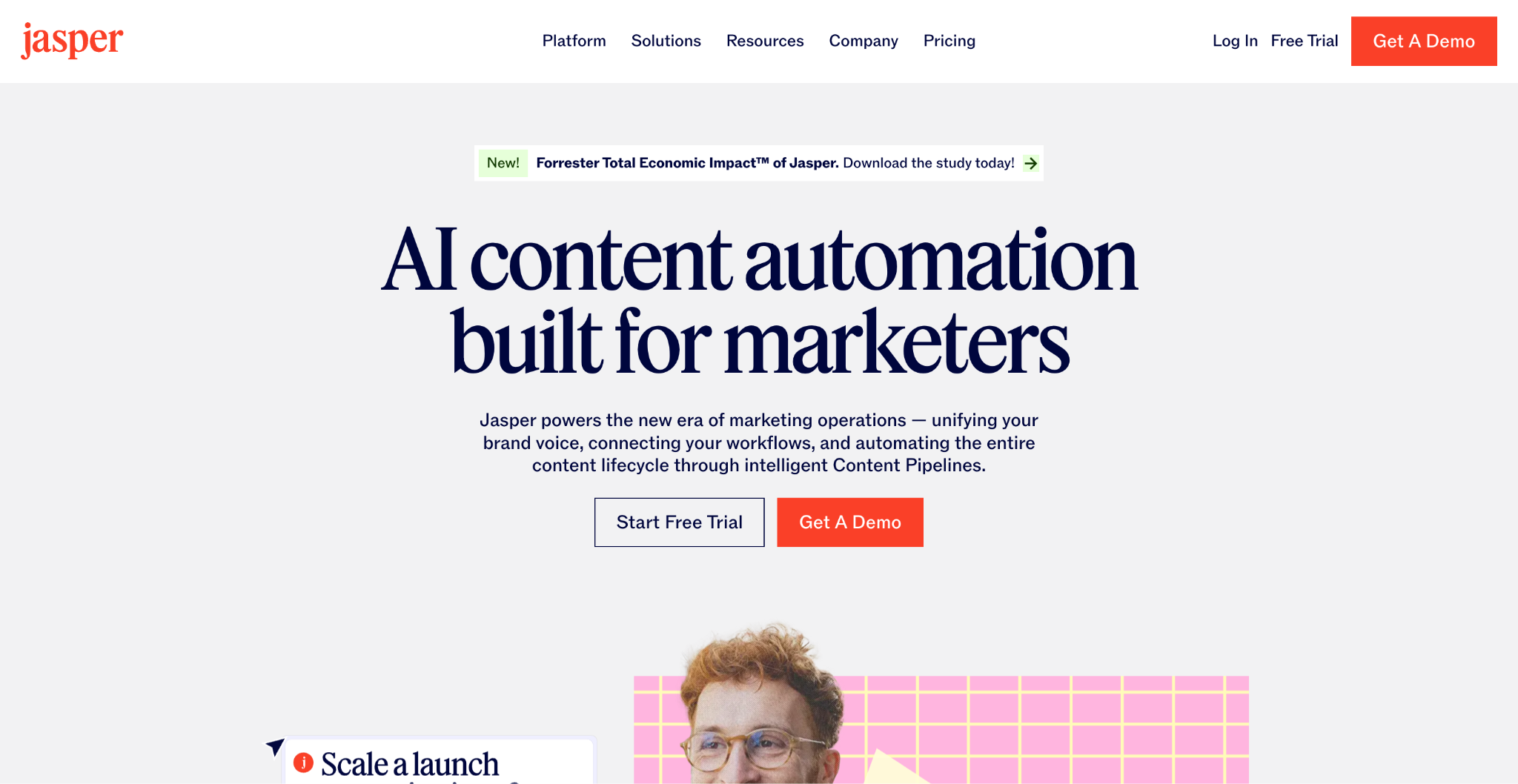
Jasper is an AI writing assistant built for marketers and content creators. It helps produce blogs, ads, and social copy that match your brand tone. You can train it with your style guide, then use it to generate drafts, brainstorm ideas, and rewrite existing content more efficiently.
Best for content teams and agencies that produce large volumes of copy.
Pros
Cons
Who gets the most value? Marketing teams are balancing quality and speed. Jasper works best when paired with human editing to turn solid drafts into great content.
Quick setup tip: Upload your brand voice samples during onboarding. Then create a few “recipes” for your most common content types so Jasper learns how you write.
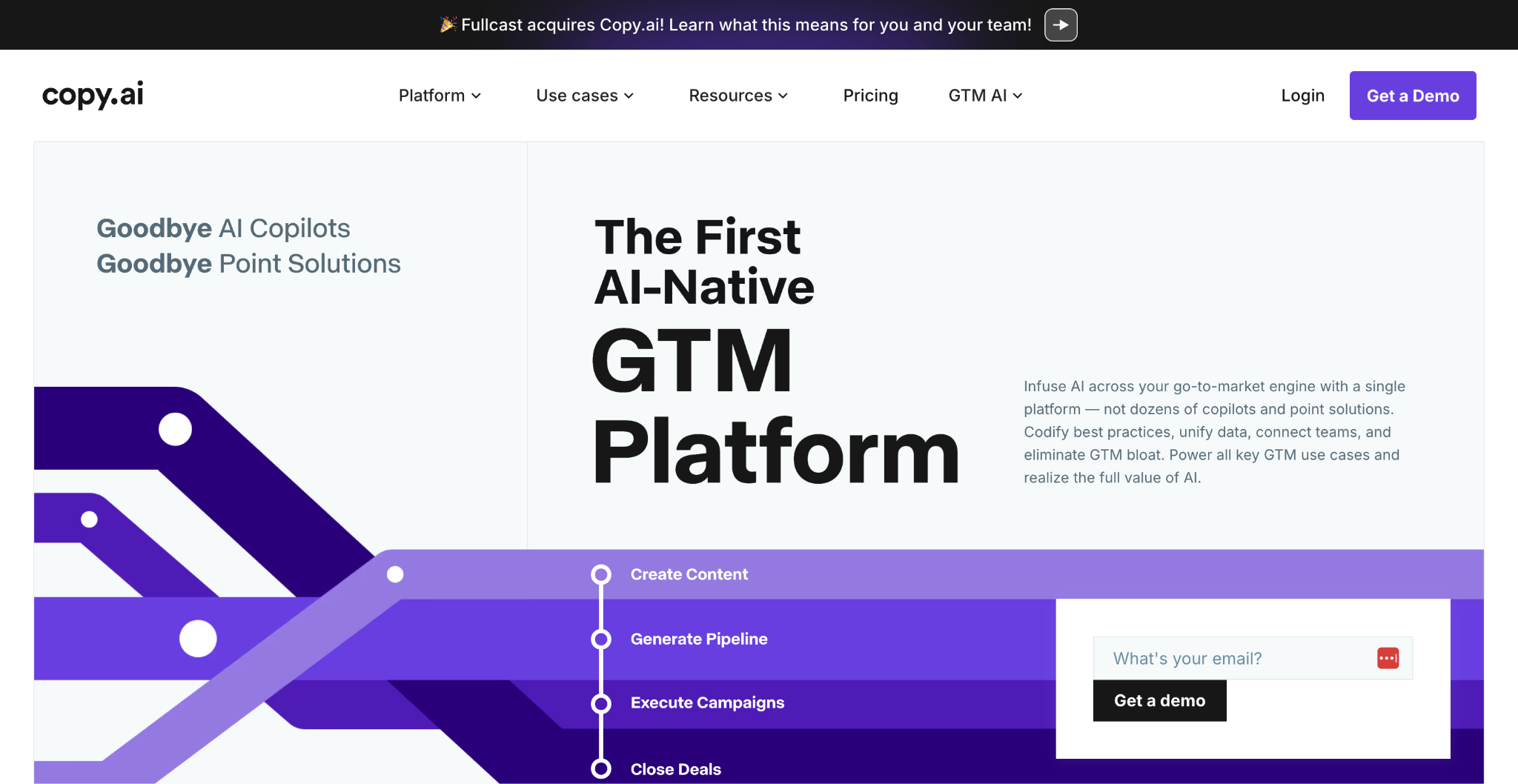
Copy.ai is designed to help marketers write high-performing short-form copy. It specializes in email subject lines, ad variations, and social captions that convert. The platform uses AI to generate multiple versions, so you can test and compare quickly without creative fatigue.
Best for growth marketers and performance teams focused on conversion-driven messaging.
Pros
Cons
Who gets the most value? Performance marketers and growth teams are testing multiple angles across channels. Copy.ai helps you move from idea to launch-ready copy within minutes.
Quick setup tip: Feed the tool examples of your highest-performing copy. Use its rewrite feature to create fresh angles for your next campaign while keeping your core message intact.
Choosing the right AI marketing tool isn’t about grabbing the flashiest new software. It’s about matching the tool to your actual goals, workflows, and team skills. The best setup fits your current stage but scales with you as you grow.
Before touching a demo or pricing page, get clear on what problem you’re solving. Do you want to generate more leads, automate campaigns, improve SEO, or understand your audience better?
If your goal is unclear, every tool will look shiny, but none will truly fit. Write down three outcomes you want to achieve, like “cut manual work by 30 percent” or “improve campaign conversion rates.” Then choose tools that directly help with those outcomes.
Not all tools are built for the same type of team. Some focus on enterprise depth, others on speed and simplicity. When comparing, look beyond feature lists and test how the tool actually fits your workflow.
Ask yourself:
The best tools are the ones your team will actually use.
AI tools depend on data. Before connecting anything, check where your data goes, how it’s stored, and who can access it. Privacy regulations like GDPR and CCPA are tightening, and you don’t want compliance surprises later.
Choose vendors that are transparent about their data sources and security practices. If you work with customer data, pick platforms that support consent management and anonymization.
AI marketing tools often start cheap and get expensive as you scale. Pay attention to pricing models. Some charge per contact or campaign, others by user or feature.
Think long term. A slightly higher upfront cost can save more later if the tool replaces several smaller ones. Also, check if the vendor integrates with your CRM, automation platform, and analytics tools. A connected stack always pays off faster than isolated apps.
Never roll out a new AI tool across your team immediately. Start with a pilot project. Use a small campaign, one audience, or one workflow to test results.
Measure what changes: time saved, engagement uplift, conversion improvement. If the tool adds value, scale from there. If it doesn’t, move on quickly.
The smartest marketing teams treat tool selection like campaign testing. They test, measure, and learn until they find what sticks.
Buying AI marketing tools is the easy part. Making them actually work inside your marketing system takes structure, patience, and clear habits. Here’s how to implement them so they drive consistent results instead of collecting digital dust.
Start with your current strategy, not the tool’s features. Every new platform should fit into your existing process. If it doesn’t connect to your goals or your funnel, it’s just another distraction.
Map your customer journey from awareness to retention, then identify where AI can make the biggest difference. For example, use automation tools to handle repetitive follow-ups, or analytics tools to spot performance gaps faster. When every tool supports a real process, your stack becomes a system instead of a pile of software.
Don’t automate everything at once. Create a roadmap that moves step by step. Start with a single use case, such as lead scoring or email scheduling. Once you have measurable success, expand into new workflows.
Keep oversight in place. Someone on your team should review AI decisions regularly. It’s easy for automations to drift off course if no one checks accuracy or performance.
AI doesn’t replace your team. It changes how your team works. Instead of spending hours writing, pulling data, or running reports, people focus on creative direction, messaging, and strategy.
Make sure every user understands the basics of the tool they’re working with. Most platforms offer short certification programs or internal training libraries. Encourage your team to experiment and share what they learn. The faster everyone gets comfortable, the faster your marketing gains compound.
AI tools only perform as well as the data you give them. If your CRM is messy or your analytics tags are broken, the output will be off. Before rolling out automation, clean your datasets and standardize fields like industry, region, or buyer stage.
Good data helps AI identify patterns and deliver accurate insights. Poor data wastes money and time. It’s that simple.
Once the system is running, track results weekly. Look for trends in engagement, conversions, and time savings. If performance dips, check whether the AI model is using old data or repeating patterns that no longer work.
AI should assist, not autopilot. Keep human creativity and context in the loop.
Here’s a quick scenario: a marketer uses Jasper to write a product email, Canva to design it, and HubSpot to automate the send. Data from opens and clicks feed into SEMrush to adjust messaging for SEO.
That loop turns one creative idea into a full performance cycle powered by connected tools and live feedback.
AI marketing success isn’t about buying smarter tools. It’s about building smarter habits.
AI marketing isn’t slowing down. It’s evolving faster than most teams can keep up with. What felt advanced a year ago is already standard today. The next wave will take automation, personalization, and creativity to another level.
Text generation was just the beginning. AI is now moving into richer formats like video, audio, and interactive content. Tools can create product videos, podcasts, and even synthetic voices that match your brand tone.
Soon, you’ll be able to generate personalized product demos or explainers for each prospect without touching a camera or script. This shift means marketing will blend more closely with entertainment and education.
AI is learning how to connect data from every platform and interaction. That means marketers can send messages that feel handcrafted but are created automatically. From dynamic website experiences to personalized outreach, one-to-one marketing is becoming a reality at scale.
Imagine sending 1,000 emails that all sound uniquely written for each person, not because a human did it, but because your system learned how.
The next generation of AI tools will operate more like digital team members. They’ll plan campaigns, test versions, analyze data, and optimize continuously with minimal input. Some companies already use AI agents that handle lead scoring, ad adjustments, and reporting automatically.
The role of the marketer will shift from doing the work to directing it, deciding strategy, and not writing prompts.
As AI becomes more powerful, responsibility matters more than ever. Governments are rolling out regulations to protect data and prevent misuse. Marketers must keep transparency front and center when using AI for personalization or targeting.
Ethical marketing means explaining how data is used, keeping customer consent clear, and avoiding manipulative tactics. Teams that respect privacy will build stronger trust and longer relationships.
AI marketing tools are spreading fast beyond North America and Europe. Markets in Asia, Africa, and Latin America are catching up quickly as local startups build region-specific AI platforms.
This creates new opportunities for cross-border growth and collaboration. The best-performing teams will be those that adapt their AI strategy for cultural differences and local consumer behaviors.




























